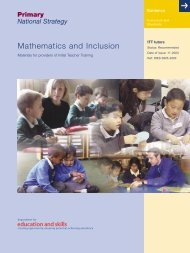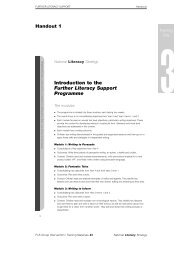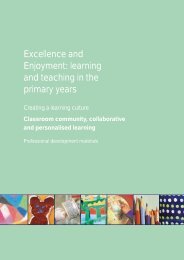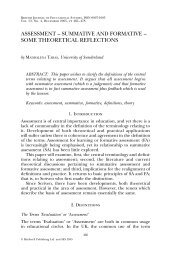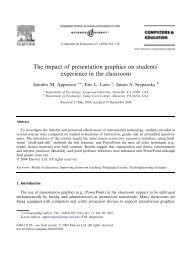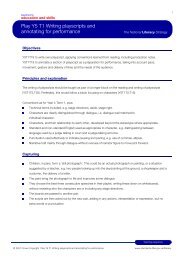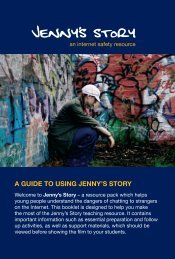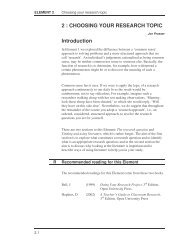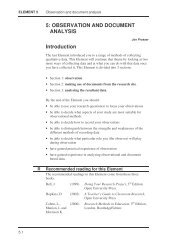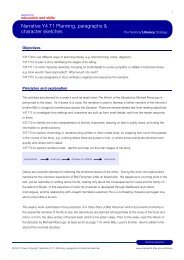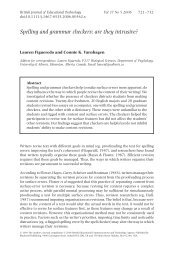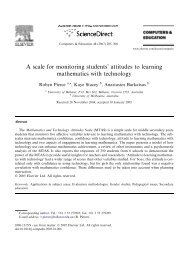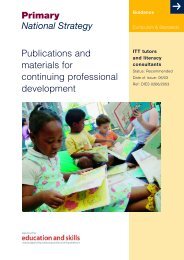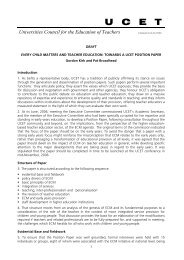Designing technology for emergent literacy: The PictoPal ... - PGCE
Designing technology for emergent literacy: The PictoPal ... - PGCE
Designing technology for emergent literacy: The PictoPal ... - PGCE
You also want an ePaper? Increase the reach of your titles
YUMPU automatically turns print PDFs into web optimized ePapers that Google loves.
Computers & Education 52 (2009) 719–729Contents lists available at ScienceDirectComputers & Educationjournal homepage: www.elsevier.com/locate/compedu<strong>Designing</strong> <strong>technology</strong> <strong>for</strong> <strong>emergent</strong> <strong>literacy</strong>: <strong>The</strong> <strong>PictoPal</strong> initiativeSusan McKenney * , Joke VoogtDepartment of Curriculum, Faculty of Behavioral Sciences, University of Twente, P.O. Box 217, 7500 AE Enschede, <strong>The</strong> NetherlandsarticleinfoabstractArticle history:Received 1 July 2008Received in revised <strong>for</strong>m 18 November 2008Accepted 20 November 2008Keywords:Early <strong>literacy</strong>Emergent <strong>literacy</strong>Technology integrationKindergarten<strong>PictoPal</strong> is the name of a <strong>technology</strong>-supported intervention designed to foster the development of <strong>emergent</strong>reading and writing skills in four and five year old children. Following the theoretical underpinningsand a brief description of <strong>PictoPal</strong>, this article describes how children worked with the <strong>technology</strong>; howthe intervention elicited their engagement with <strong>literacy</strong> concepts both on the computer and off; andeffects on early <strong>literacy</strong> learning. Observation results indicate that children are able to work independentlywith the program after a few instruction sessions. Observation data yield insight in the natureof adult guidance and the way the results of computer activities were implemented in off-computerclassroom activities, as well as areas where this could be improved. Comparison of the four pre–post testexperiments used to assess learning effects, suggest that the on-computer activities in <strong>PictoPal</strong> can yield astatistically significant learning effect, but only when integration with off-computer activities is present.Ó 2008 Elsevier Ltd. All rights reserved.1. IntroductionIn the Netherlands, interest in supporting the development of <strong>emergent</strong> <strong>literacy</strong> has been growing in the last decade (McKenney,Letschert, & Kloprogge, 2007). This is exemplified by the recent establishment of a national expertise center that aims to promoteinteractive Dutch language instruction, as well as increased funding <strong>for</strong> language programs, especially those targeting at-risk childrenin the 3–5 age bracket (e.g., Corvers, Aarnoutse, & Peters, 2004). <strong>The</strong> specification of language attainment targets <strong>for</strong> 4–6 year old children(Verhoeven & Arnoutse, 1999) further demonstrates the commitment to taking early language development seriously, yet manyDutch kindergarten teachers struggle to work with them. In the Netherlands and abroad, support tools have been created to helpteachers make effective use of early <strong>literacy</strong> attainment targets (e.g., Bronkhorst, Paus, & Wentink, 1999; Daro, Hampton, & Resnick,2004).<strong>The</strong> study reported on here took place in the Netherlands, where most children attend both junior and senior kindergarten. Variouslanguage curricula are available <strong>for</strong> use among this age group, with Schatkist (‘‘Treasure Chest”) being among the most popular.National goals <strong>for</strong> early <strong>literacy</strong> (Verhoeven & Arnoutse, 1999) may be clustered into three main areas: (a) language consciousness,alphabetic principles, technical reading and writing; (b) book orientation, story understanding and reading and writing comprehension;and (c) functions of written language, relationship between spoken and written language, functional reading and writing. Previousresearch has examined the potential <strong>for</strong> software to offer added-value in learning alphabetic principles and the technicalaspects of reading and writing (Segers & Verhoeven, 2002, 2005) as well as book orientation and story understanding (de Jong &Bus, 2003, 2004). This study examines how the computer can contribute to an understanding of the nature and function of writtenlanguage. Doing so requires that attention be given to the relationship between spoken and written language and the purposes <strong>for</strong>which reading and writing are used. As in oral language learning, children’s concept <strong>for</strong>mation regarding written language is drivenby its use, in an environment rich with meaningful messages and functional print (Van Scoter, 2008; Warash, Strong, & Donoho,1999). <strong>The</strong> <strong>PictoPal</strong> learning environment was developed with the aim of fostering a better understanding of the nature and functionof written language. <strong>The</strong> environment contains integrated on- and off-computer activities. <strong>The</strong> main question shaping this study was‘‘How can the <strong>technology</strong>-supported learning environment, <strong>PictoPal</strong>, contribute to helping kindergarteners understand the nature andfunction of written language?”* Corresponding author. Tel.: +31 (0)53 489 2890; fax: +31 (0)53 489 3759.E-mail address: susan.mckenney@utwente.nl (S. McKenney).0360-1315/$ - see front matter Ó 2008 Elsevier Ltd. All rights reserved.doi:10.1016/j.compedu.2008.11.013
S. McKenney, J. Voogt / Computers & Education 52 (2009) 719–729 721Segers, Bronkhorst, & Boyes, 2006). Such programs must there<strong>for</strong>e be designed with a working knowledge of young children’s use of visualmedia in meaning-making, as studied by Turbill (2001) and Walsh (2003).Realistic conceptions of computer practices and abilities of this age group are required; and research in this area is growing (Brooker &Siraj-Blatch<strong>for</strong>d, 2002; Hill, 2004; Xiaoming & Atkins, 2004). Designers of educational software <strong>for</strong> use by junior and senior kindergartenchildren stress the need <strong>for</strong> features tailored to ergonomic needs of this age group, such as large buttons, oversized cursors, minimal need<strong>for</strong> ‘‘dragging” icons (Segers & Verhoeven, 2002). Usability testing must consequently be adjusted to the developmental abilities of the targetaudience (see Hanna, Risden and Alexander (1997) <strong>for</strong> guidelines). Simultaneously, attention must be given to potentially counterproductivefeatures such as cued animations or sound effects that can provide inconsiderate distractions and have adverse effects on pupilconcentration (Trushell & Maitland, 2005). In a similar vein, care must be taken when selecting hardware as some promote negative ratherthan positive collaborations; this has been the case with touch-screen technologies that allow children to pursue their individual goals asopposed to encouraging them to cooperate and achieve a common goal via one available input device (Romeo, Edwards, McNamara, Walker,& Ziguras, 2003).Many software applications <strong>for</strong> early <strong>literacy</strong> development are isolated programs; few are attuned to desired pedagogical practiceswithin kindergarten classrooms as a whole. For this reason, researchers mention the lack of pedagogical models underpinning many <strong>technology</strong>applications <strong>for</strong> use with this age range (e.g., Plowman & Stephen, 2003, 2005; Trushell & Maitland, 2005; Verhoeven et al., 2006). Inthe design of <strong>PictoPal</strong>, we aimed specifically toward realizing a <strong>technology</strong>-supported intervention, while also explicitly addressing integrationwith other developmentally appropriate, off-computer practices in the kindergarten. Speaking to the a<strong>for</strong>ementioned void of researchon production of texts in <strong>technology</strong>-supported early <strong>literacy</strong> research, the <strong>PictoPal</strong> intervention builds on principles of socialinteraction and meaning-making through its emphasis on generating real documents on the computer which are then used in dramaticplay and/or authentic settings.3. About <strong>PictoPal</strong>3.1. Ideas underpinning <strong>PictoPal</strong> design<strong>The</strong> <strong>PictoPal</strong> intervention was designed to help meet national interim goals <strong>for</strong> early <strong>literacy</strong>. <strong>The</strong> primary focus was on understandingthe nature of written language. Secondarily, the program was designed to help children recognize (a) the relationship between spoken andwritten language; and (b) purposeful reading and writing. <strong>The</strong> use of <strong>technology</strong> in the <strong>PictoPal</strong> endeavor centers on writing and generatingdocuments on the computer to be used either as literary props or <strong>for</strong> authentic purposes in the off-computer activities. Using <strong>technology</strong> inthis way is consistent with Papert’s (1980) ideas on constructionism, where children should be enabled to ‘‘learn by making”.<strong>The</strong> research presented in the previous section sculpted a pedagogically appropriate design of <strong>PictoPal</strong>. Four parameters guided the designof <strong>PictoPal</strong>: <strong>PictoPal</strong> should be an open learning environment that facilitates children’s active role in creating written products which may be used<strong>for</strong> a variety of purposes and in authentic ways. <strong>PictoPal</strong> on-computer activities should elicit dialogue and collaboration, preferably with adults as well as peers. <strong>The</strong> products of <strong>PictoPal</strong> computer activities should be used in related off-computer activities, to promote print-enriched play andauthentic use, and to encourage interaction and language use in meaningful social settings. <strong>The</strong> design of the <strong>PictoPal</strong> computer environment should be guided by usability testing so as to address the ergonomic needs ofkindergarteners.In addition to these guidelines and the theoretical foundations described above, three convictions are central to the design of the <strong>PictoPal</strong>intervention: Children want to express themselves in print, even be<strong>for</strong>e they are able to read. <strong>The</strong> powerful combination of images and print can help children to express themselves. <strong>The</strong> computer can offer added-value by helping children to focus on <strong>for</strong>mulating their message rather than the mechanics of writing.<strong>The</strong> component description below explains how the design guidelines ideas took shape.3.2. <strong>PictoPal</strong> componentsIn the <strong>PictoPal</strong> project, pupils’ language development and linguistic conceptual understanding are fostered through their interaction inthree social settings: (a) collaboration while using the computer to compose written documents; (b) shared pretend play using printouts ofthe written documents as literary props (e.g., grocery lists to ‘use’ in the store corner; recipes <strong>for</strong> ‘cooking’ in the classroom kitchen) and (c)sharing printed work with a wider audience (e.g., letters to family are mailed; poems are read aloud at circle time).Three versions of <strong>PictoPal</strong> were designed, evaluated and revised. All versions of the <strong>PictoPal</strong> learning environment contained on- and offcomputeractivities; the main differences are summarized in Table 1. <strong>The</strong> first version was created using Authorware Ò , subsequent prototypesmade use of an existing tool: Clicker Ò . In addition to semi-open activities, the first version of <strong>PictoPal</strong> also contained closed activitiesthrough which the children could learn the pictogram vocabulary. After the first study, it became clear that no practice was necessary tofacilitate understanding of the image–word relationship, so the closed items were discarded, and a wider range of pictograms was thendeemed acceptable. Starting with the second prototype, the on-computer activities have made use of Clicker Ò software. Clicker Ò is a visualword processor; it allows children to click on images and/or words to type complete words at a time. Once the closed items were discarded,Clicker Ò was viewed as preferable because the production of new semi-open activities requires substantially less technical expertise. WithClicker Ò , teachers could be involved in the design of the semi-open activities. <strong>The</strong> duration of the first intervention was extremely short;
722 S. McKenney, J. Voogt / Computers & Education 52 (2009) 719–729Table 1Overview of the <strong>technology</strong> component of the three <strong>PictoPal</strong> prototypes.Version 1 Version 2 Version 3Plat<strong>for</strong>m Authorware Ò Clicker Ò Clicker ÒPictograms used Black and white line drawings Mixed <strong>for</strong>ms of clip art Mixed <strong>for</strong>ms of clipartNumber of assignments 4 8 8Type of assignments Closed and semi-open Semi-open Semi-openTopics addressed Everyday activities Houses <strong>The</strong> weatherSupport <strong>for</strong> childrenInteractive agentFig. 1. Sample grid.this was doubled in the second version and kept as such when more promising results were found in the second study. Each prototypeaddressed different themes, with coordinated on- and off-computer activities. <strong>The</strong> last prototype included modest use of an interactiveagent.Each semi-open on-computer activity features the creation of a particular text type (letter, poem, list, etc.). <strong>The</strong> documents resultingfrom computer use are then integrated with off-computer activities in the classroom (e.g., letters are mailed, poems read aloud, groceries‘bought’ in the store corner, etc.). Fig. 1 shows a sample screen with two parts: the top shows the document being created; and the bottom(translated) Clicker Ò grid, allows the young users to create texts without typing or even being able to read. <strong>The</strong> two images in Fig. 2 demonstratehow children use the computer to generate meaningful texts (left), which are then printed and used in the classroom play corners(right).4. Studies examining the effects of <strong>PictoPal</strong>4.1. Research approach<strong>The</strong> <strong>PictoPal</strong> inquiry may best be characterized as design research (cf. McKenney, van den Akker, & Nieveen, 2006), and thus also aimedtoward explication of the ideas underpinning the design with the hope of contributing to knowledge building and helping other designersto generate ideas <strong>for</strong> use in their own settings (McKenney, 2008). Based on the findings from the literature review three prototypes were(re)designed and <strong>for</strong>matively evaluated. During the cyclic process of design, <strong>for</strong>mative evaluation and revision of the three <strong>PictoPal</strong> versions,answers were sought to the following main question: ‘‘How can the <strong>technology</strong>-supported learning environment, <strong>PictoPal</strong>, contributeto helping kindergarteners understand the nature and function of written language?”Fig. 2. Child with adult guide (here a student teacher) writing recipes (left); another cooking it all up (right).
S. McKenney, J. Voogt / Computers & Education 52 (2009) 719–729 723Several characteristics in the <strong>technology</strong>’s design warranted usability testing, as these were seen to be pre-requisites to being able tomake meaningful use of the system. <strong>The</strong>re<strong>for</strong>e, be<strong>for</strong>e being able to answer the main research question, examination of learner abilitiesto work with the <strong>technology</strong> was needed. <strong>The</strong> importance of play and social interaction in the <strong>PictoPal</strong> intervention required examinationof the function of guidance by adults and the implementation of off-computer activities in the classroom. Since <strong>PictoPal</strong> ultimately aimed tocontribute to the development of early <strong>literacy</strong>, the nature and function of written language in particular, pupil knowledge and skills in thisdomain were also studied. In summary, data were collected in the following three domains throughout the research and developmentcycles:(1) Learner’s ability to use the <strong>technology</strong> component of <strong>PictoPal</strong>: mouse operation; comprehension of the computerized voice; and abilityto work independently.(2) Eliciting engagement: primarily related to function of adult guides and the implementation of off-computer activities in theclassroom.(3) Literacy knowledge and skills: primarily related to the functions of written language; secondarily related to the relationship betweenspoken and written language and purposeful reading and writing.Four small scale studies were conducted during the design and evaluation of the three prototypes. Research assistants collected the datain each study. Three schools and eight teachers participated in the four studies on a voluntary basis. All pupils (n = 172) of these teachersparticipated in the study, either in the experimental or control condition. <strong>The</strong> on-computer activities took place in computer clusters, justoutside the classrooms. <strong>The</strong> first two studies were very limited and aimed at exploring the potential of the <strong>PictoPal</strong> environment <strong>for</strong> early<strong>literacy</strong> development. <strong>The</strong> third and fourth studies were conducted on a somewhat larger scale. In these studies the implementation of theoff-computer activities and the role of adult guidance were explored. Data collection and findings of the four studies are presented below.4.2. Study 14.2.1. Focus<strong>The</strong> first study reported here used the first prototype, <strong>PictoPal</strong> (v1). In this prototype, closed activities as well as semi-open activitieswere offered to the pupils. <strong>The</strong> closed activities were very structured and made use of pre-determined pictograms, which were also usedin a common paper-based method (de Wit-Gosker, 1990). <strong>The</strong> activities emphasized recognition of the images and using them to ‘read’sentences composed of pictograms. <strong>The</strong> semi-open activities were less structured. <strong>The</strong>y focused on ‘writing’ and authentic applicationsin classroom practice. Although the children printed their products, this early evaluation <strong>for</strong>mat offered little opportunity to explorethe engagement aspect of the off-computer activities. Study 1 focused on learner abilities to use the <strong>technology</strong> component of the <strong>PictoPal</strong>environment (1) and learner’s gains in early <strong>literacy</strong> skills, particularly those related to the function and nature of written language (3).4.2.2. MethodsSubjects: Kindergarten children from two schools were divided into experimental (n = 21) and control groups (n = 19), matched <strong>for</strong> age,gender, language skills (based on a national language test <strong>for</strong> kindergarteners) and remediation offered. One of each pair was randomlyassigned to either the control or the experimental group. <strong>The</strong> experimental group worked with the <strong>PictoPal</strong> environment four times overa period of five weeks. One computer session took about 20 min.Instruments: Pupils from the experimental group were observed during their <strong>PictoPal</strong> (v1) sessions. With the help of an observationchecklist, the researcher charted whether children needed no, some or much assistance needed while working with the environment, incomprehending the computer voice and in operating the mouse. In addition, pre- and a post-test were given to the experimental andthe control groups. <strong>The</strong> Early Literacy Skills Test was developed by the researchers and validated by an early language expert. <strong>The</strong> itemswere based on those standards <strong>for</strong> early <strong>literacy</strong> that focused on the nature and function of written language (Verhoeven & Arnoutse, 1999).<strong>The</strong> reliability of the test was acceptable (Cronbach’s alpha = 0.85). <strong>The</strong> items were distributed proportionally to the main goals of <strong>PictoPal</strong>:nine items relate to functional reading and writing (using written language <strong>for</strong> communicative purposes); four items relate to functions ofwritten language; two items pertain to the relationship between spoken and written language; and two items address language consciousness.Here are two examples: Understanding text types (functional reading and writing): When given a grocery list, a postcard, a cookbook and a picture book, childrenwere asked to point to the postcard. Distinguishing <strong>for</strong>m from meaning (language consciousness): Children were given corresponding animal picture–word combinations andtold what words were written. <strong>The</strong>n they were asked to identify which word (not animal) is the biggest (an English example: the wordmosquito is biggest, but the cow is the biggest animal in the set).4.2.3. Results<strong>The</strong> results, presented in Table 2, show that learners were able to work mostly independently with the program after some initial help.Kindergarteners possessed sufficient motor skills to use the mouse and with a brief introduction, they adjusted to the computer voice aswell. After three to four sessions, most pupils were able to grasp the assignments and carry them out with little help. <strong>The</strong> effect size (Cohen’sd) between sessions 1 and 4 showed that pupils particularly improved in their understanding of the semi-open assignments and inusing the mouse when working with these assignments. This was encouraging because it also showed that pupils can learn to work independentlywith the less structured assignments, which is more challenging to implement (than structured assignments) but more in linewith the goals of the intervention.Table 3 presents the mean scores and standard deviations of the experimental and control group pre- and post-tests. To determinelearning effects, the learning gain was calculated (learning gain is post- and pre-test scores). Both groups had a significant learning gain(control group t(18) = 3.26, p = 0.004; experimental group t(20) = 3.17, p = 0.05), as could be determined with a paired-t-test. Although
724 S. McKenney, J. Voogt / Computers & Education 52 (2009) 719–729Table 2Ability of experimental group pupils to independently understand the assignments and operate the mouse (Study 1).M(SD)Effect sizeSession 1 Session 2 Session 3 Session 4 Sessions 1–4Understands (closed assignments) 1.71(0.78) 1.81(0.68) 1.57(0.75) 1.33(0.66) 0.53Understands (semi-open assignments) 2.14(0.57) 2.14(0.73) 1.90(0.77) 1.67(0.58) 0.82Mouse use (closed assignments) 1.52(0.75) 1.38(0.67) 1.33(0.66) 1.24(0.54) 0.43Mouse use (semi-open assignments) 2.00(0.63) 1.62(0.74) 1.71(0.72) 1.43(0.60) 0.93Note: scored on a three point scale: 3 = needs a lot of help; 2 = needs a little help; and 1 = needs no help.Table 3Mean scores (M), standard deviation (SD) of pre- and post-test scores, learning gain and effect size on the Early Literacy Skills Test of the experimental and control group (Study 1).n Pre-test M(SD) Post-test M(SD) Learning gain M(SD) Effect sizeExperimental condition 21 0.57(0.24) 0.65(0.25) 0.07(0.11) 0.30Control condition 19 0.64(0.23) 0.70(0.20) 0.06(0.08) 0.28the experimental group had a slightly higher learning gain, the effect size is about the same <strong>for</strong> both groups. After four computer sessionswith <strong>PictoPal</strong>, no convincing evidence was found to indicate that the intervention improves <strong>emergent</strong> reading and writing skills. However,the results as shown in Table 2 also indicated that in the first study positive effects probably could not be confirmed, because of the shortduration and incidental use of <strong>PictoPal</strong>. Further research was deemed necessary to study the effect of <strong>PictoPal</strong> when used more frequentlyand over a longer period of time.4.3. Study 24.3.1. Focus<strong>The</strong> findings from the first study had showed that pupils can learn to work with the semi-open assignments in <strong>PictoPal</strong> quickly. Thisimplied that initial teacher investment would be needed but that it could fade after three to four sessions. Additionally, all participants(children, teachers and experts) agreed that the semi-open assignments featuring real-world applications were more interesting, motivating,challenging and meaningful. For these reasons the second version of <strong>PictoPal</strong> (v2) contained only semi-open assignments. <strong>The</strong> <strong>PictoPal</strong>(v2) activities <strong>for</strong> the second study were designed by the participating teacher together with the researchers and were related to a currentclassroom theme. In contrast to the extremely brief treatment in the first study, the number of <strong>PictoPal</strong> sessions was doubled. As in theprevious study, a computer session took about 20 min. To address the need <strong>for</strong> adult guidance, the decision was made to explore theuse of parent volunteers when the children used <strong>PictoPal</strong>. Videos were taken of the on- and off-computer activities, but no structuredobservations took place. Data were collected on learner gains in early <strong>literacy</strong> skills, particularly those related to the function and natureof written language (3).4.3.2. MethodsSubjects: Kindergarten children from one school were divided into experimental (n = 7) and control groups (n = 7). As in the previousstudy, the pupils were matched <strong>for</strong> age, gender, language skills (based on a national language test <strong>for</strong> kindergarteners) and remediationoffered. One of each pair was randomly assigned to either the control or the experimental group. <strong>The</strong> experimental group worked oncea week with <strong>PictoPal</strong>, in total eight times.Instruments: <strong>The</strong> Early Literacy Skills Test was slightly revised (Cronbach’s alpha = 0.87) and administered to pupils from the experimentaland control group be<strong>for</strong>e and after the treatment.4.3.3. ResultsTable 4 presents the mean scores and standard deviations of the experimental and control group. A large learning gain was found <strong>for</strong> theexperimental group. Using the Mann–Whitney U test, a significant difference in learning effects was determined <strong>for</strong> the experimental versusthe control group (Z = 2.256, p < .024). <strong>The</strong> effect size <strong>for</strong> the experimental group was considerably higher compared to the controlgroup. After eight computer sessions with <strong>PictoPal</strong>, evidence was found to indicate that the <strong>PictoPal</strong> intervention improves <strong>emergent</strong> readingand writing skills. However, it must be noted that the experiment was very small and conclusions have there<strong>for</strong>e a limited meaning. Forthis reason follow-up studies with a larger number of children was conducted (Studies 3 and 4).4.4. Study 34.4.1. Focus<strong>The</strong> third study was conducted with the third version of <strong>PictoPal</strong> (v3). <strong>The</strong> new theme was created to tie into the school-wide thematicscience month on weather. In this study, the experimental group worked with <strong>PictoPal</strong> computer activities, while the control group used anTable 4Mean scores (M), standard deviation (SD) of pre- and post-test scores, learning gain and effect size on the Early Literacy Skills Test of the experimental and control group (Study 2).n Pre-test M(SD) Post-test M(SD) Learning gain M(SD) Effect sizeExperimental condition 7 0.68(0.20) 0.96(0.21) 0.27(0.64) 1.36Control condition 7 0.55(0.31) 0.60(0.24) 0.05(0.20) 0.18
S. McKenney, J. Voogt / Computers & Education 52 (2009) 719–729 725alternative language program: ‘Kijken en Kiezen’ (‘Look and Choose’). Kijken en Kiezen was designed by the author of the pictogram setdescribed in the first <strong>PictoPal</strong> prototype, and uses those same images to introduce children to written language. As in the second study,pupils in the experimental group were engaged in eight <strong>PictoPal</strong> computer activities of 20 min each. Similarly, control group childrenhad eight computer sessions of 20 min. As in the second study, parents were available to elicit dialogue and interaction during the on-computersactivities of <strong>PictoPal</strong>, but no structured observations on how parents coached the children were carried out. <strong>The</strong> main focus of thisstudy was a first exploration of the implementation of the off-computer classroom activities. <strong>The</strong> learner’s products resulting from the <strong>PictoPal</strong>computer activities were printed and used in classroom applications. Six observations, of 15–25 min each, have been carried out intwo kindergarten classrooms. In the classroom activities, children from the experimental and from the control group participated. In Study3, data were collected on teacher’s use of and students’ attitudes towards the off-computer activities (2) and on learning gains in early <strong>literacy</strong>skills, particularly those related to the function and nature of written language (3).4.4.2. MethodsSubjects: 79 junior and senior kindergarteners from one elementary school (new in the study) participated. <strong>The</strong> pupils were matched inthe same way as in the previous studies. One of each pair was randomly assigned to either the control (n = 39) or the experimental group(n = 40). Two teachers were observed, while they were implementing the products of <strong>PictoPal</strong> computer activities in the classroom.Instruments: An off-computer observation scheme was developed in which brief open descriptions could be noted related to sevenareas: teacher enthusiasm; intensity of the class activity; teacher-made connections between on- and off-computer activities in the class;organization of the activities; teacher <strong>literacy</strong>-consciousness; behaviour of learners who did and who did not use <strong>PictoPal</strong> computer activities.<strong>The</strong> Early Literacy Skills Test was also used (Cronbach’s alpha = 0.65) and administered to pupils from the experimental and controlgroup be<strong>for</strong>e and after the treatment.4.4.3. ResultsA paired-t-test has been used to analyze the differences in learning gain between the experimental and the control group. <strong>The</strong> results arepresented in Table 5. <strong>The</strong> experimental group had a significantly higher learning gain compared to the control group (experimental group:t(39) = 2.65, p = 0.01); control group: t(38) = 0.00, p = 1.00). <strong>The</strong> effect size <strong>for</strong> the experimental group (0.41) was considerably highercompared to the control group (no effect).<strong>The</strong> observation results of the off-computer activities (see Fig. 3) indicate that teachers grew in their role. In the first lessons they wereawaiting and classroom organization was messy. In later lessons, organizational matters faded to the background, and teachers seemedmuch more able to connect on- and off-computer activities and to relate the activities with early <strong>literacy</strong> goals. Also the children had toget used to their new roles initially. <strong>The</strong> users of <strong>PictoPal</strong> computer activities (pupils of the experimental group) felt unsure about whatwas expected from them in the first lessons but a steady growth in confidence and enthusiasm was observed. Among the observers (thosewho did not create documents themselves, because they were part of the control group), interest and curiosity grew with each session.4.5. Study 44.5.1. Focus<strong>The</strong> fourth study was also conducted with <strong>PictoPal</strong> (v3), and centered on the role of the adult guides during <strong>PictoPal</strong> computer sessions.As in the third study the experimental group worked with <strong>PictoPal</strong> computer activities, while the control group used an alternative languageprogram (‘Kijken en Kiezen’ – ‘Look and Choose’). <strong>The</strong>re were eight computer sessions <strong>for</strong> the experimental and control group; eachsession took about 20 min. During eight weeks, parents coached 4–5 children from the experimental group during the 20-min computersessions. <strong>The</strong> parents encouraged dialogue and interaction related to the computer assignments by asking questions such as ‘‘what did youwrite?” Data collection in this study focused on adult guidance (2) and on learner’s gains in early <strong>literacy</strong> skills, particularly those related tothe function and nature of written language (3).4.5.2. MethodsSubjects: <strong>The</strong> study was conducted with 37 junior and senior kindergarteners from the same school that participated in the secondstudy, but with different children. <strong>The</strong> same matching procedure as applied in the other studies was used resulting in an experimentalgroup of 19 and a control group of 18 children. In addition, four parents participated in the study. <strong>The</strong>se parents were asked by the teacherto volunteer as an adult guide. Children from the experimental group were each week randomly assigned to an adult guide.Instruments: <strong>The</strong> on-computer adult–child interaction observation scheme was based on an instrument created by Damhuis, de Blauw,and Brandenbarg (2004). With the observation scheme, data on adult–child interaction were scored as not present, sometimes present andregularly present with regard to: creating the necessary conditions <strong>for</strong> engagement (e.g., a safe learning climate and the desire to communicate);providing language offerings (e.g., speaking clearly and correctly, helping children articulate themselves); creating space <strong>for</strong> activeparticipation in a conversation (e.g., leaving silences unfilled, giving verbal and non-verbal responses); stimulating linguistic development(e.g., elaborating on what children contribute, introducing more complex linguistic functions); and offering feedback (e.g., implicit corrections,summarizes). As in the other studies the Early Literacy Skills Test was used (Cronbach’s alpha = 0.77) and administered to pupils fromthe experimental and control group be<strong>for</strong>e and after the treatment.Table 5Mean scores (M), standard deviation (SD) of pre- and post-test scores, learning gain and effect size on the Early Literacy Skills Test of the experimental and control group (Study 3).n Pre-test M(SD) Post-test M(SD) Learning gain M(SD) Effect sizeExperimental condition 40 0.79(0.15) 0.85(0.14) 0.06(0.14) 0.41Control condition 39 0.81(0.14) 0.81(0.12) 0.00(0.17) 0.00
726 S. McKenney, J. Voogt / Computers & Education 52 (2009) 719–729Fig. 3. Summary of observation results (Study 3).4.5.3. ResultsWith a paired-t-test the differences in learning gain between the experimental and the control group have been determined. In thisstudy a significant higher learning gain of the control group was found compared to the experimental group (experimental group:t(18) = 4.28, p = 0.674); control group: t(17) = 3.03, p = 0.007). <strong>The</strong> effect size <strong>for</strong> the control group is 0.53, and much higher than theeffect size in the experimental group. <strong>The</strong> results are presented in Table 6.Although the findings of the first pilot study suggest that pupils may be able work independently with <strong>PictoPal</strong>, developmentally appropriatepractice suggests that some degree of adult guidance is preferable during the on-computer activities, to encourage dialogue andinteraction. In the fourth study structured observations were conducted to help understand the nature of the interactions as well as to learnabout where to target potential training <strong>for</strong> adult guides, only technical (not pedagogical) instruction was given prior to use with the children.Four adult guides were observed during eight computer sessions with <strong>PictoPal</strong>. As illustrated by the summary in Fig. 4, it appearedthat adults were able to create a safe climate and room <strong>for</strong> active involvement of pupils in the conversation. <strong>The</strong> four adults differed in thekind of feedback they gave to the pupils with two of them providing various <strong>for</strong>ms of feedback. Most of the adults (except one) had difficultiesin interacting with pupils aiming at encouraging quality: continuation/expansion of a topic, negotiation of meaning and initiatingTable 6Mean scores (M), standard deviation (SD) of pre- and post-test scores, learning gain and effect size on the Early Literacy Skills Test of the experimental and control group (Study 4).n Pre-test M(SD) Post-test M(SD) Learning gain M(SD) Effect sizeExperimental condition 19 0.77(0.10) 0.78(0.14) 0.01(0.95) 0.08Control condition 18 0.63(0.19) 0.72(0.15) 0.92(0.13) 0.53
S. McKenney, J. Voogt / Computers & Education 52 (2009) 719–729 727Fig. 4. Averaged observations <strong>for</strong> the parent–child interaction.reflection and higher level of language use. While all four adults created space <strong>for</strong> active participation, only one of them regularly posedopen questions and offered stimulating comments.5. Discussion and conclusionsThis study sought to understand how <strong>PictoPal</strong> could contribute to fostering early <strong>literacy</strong>. In so doing, three areas were examined: learnerabilities to use the <strong>technology</strong>, pupil engagement and <strong>literacy</strong> learning; the first two being viewed as pre-requisites <strong>for</strong> the latter. <strong>The</strong>findings of the first study demonstrate that kindergarteners are able to use the <strong>technology</strong> independently, after initial coaching. <strong>The</strong> secondstudy mainly dealt with setting up a system of adult guides to promote dialogue and interaction during the on-computer activities of <strong>PictoPal</strong>.Pupil engagement was more systematically studied in Studies 3 and 4. Two levels of engagement were explored: the implementationof off-computer activities (Study 3) and the role of adult guidance (Study 4). Both were important components of the design of the <strong>PictoPal</strong>intervention. In all four studies, children’s <strong>literacy</strong> knowledge and skills regarding functions of written language were addressed.<strong>The</strong> off-computer learner engagement data from Study 3 suggests that it takes three or four sessions be<strong>for</strong>e the activities become enoughof an organizational routine and the students find their way sufficiently to allow the engagement with the content to blossom. A problemin the third study was of course that about half of children had not been actively involved in the creation of documents, because theywere part of the control group. Further, more in-depth research about the implementation of off-computer activities in a more naturalclassroom setting (i.e., without experimental-control groups) would be useful to better understand the function of on- and off-computeractivities in the learning process of the children. <strong>The</strong> implementation of off-computer activities might also be easier when on- and off-computeractivities are better linked to current classroom themes. This could particularly be realized if teachers are involved in the design of<strong>PictoPal</strong> on- and off-computer activities.<strong>The</strong> findings of the fourth study suggest that untrained adults had difficulties in interacting with pupils aiming at encouraging quality,particularly related to higher levels of language use. To be able to elicit dialogue and interaction, a clear need <strong>for</strong> training was observed.Next, teachers preferred pupils’ independent work with the computer activities in <strong>PictoPal</strong> because of the extra burden they experienced inarranging <strong>for</strong> adult guides. However, such an approach would fail to use the computer interactions as a catalyst <strong>for</strong> social interaction, aspreviously described. With this goal in mind, it would seem worth considering the value of pairing older and younger children and givingthem clear roles in collaboration.<strong>The</strong> pre- and post-test learning data are inconclusive, as two of the four studies showed that significant learning gains were made. <strong>The</strong>main difference between those studies and the two where no significant learning gains were made was the integration of off-computeractivities in the classroom. This suggests that using the products of the on-computer activities <strong>for</strong> authentic purposes and dramatic playin the classroom is essential to fostering pupil learning. This explanation would concur with current views that <strong>literacy</strong> development isdriven by meaning-making (Neuman, Copple, & Bredekamp, 2000; Warash et al., 1999). However, because of the limited scope of the studywith regard to the relation between computer activities and integrated classroom activities, further research is necessary to verify or denythis explanation.<strong>The</strong> overarching question driving the <strong>PictoPal</strong> studies was, ‘‘How can the <strong>technology</strong>-supported learning environment, <strong>PictoPal</strong>, contributeto helping kindergarteners understand the nature and function of written language?” Based on the findings and discussion, several conclusionsmay be drawn. First, the <strong>technology</strong>-supported learning environment, <strong>PictoPal</strong>, can contribute to understanding the function ofwritten language when pupils are provided with guidance <strong>for</strong> at least the first few sessions, facilitating the development of the <strong>technology</strong>skills necessary to use the software. Additionally, <strong>PictoPal</strong> can contribute to eliciting learner engagement during on-computer sessions; this
728 S. McKenney, J. Voogt / Computers & Education 52 (2009) 719–729should be further stimulated by a guide (older child or adult). Untrained guides tend to naturally stimulate conversation, but are less inclinedto promote further engagement with the content. Off-computer activities also elicit learner engagement, but without support, teachersneed several sessions <strong>for</strong> this aspect to develop. Finally, use of the <strong>PictoPal</strong> system can lead to gains in <strong>literacy</strong> knowledge and skills, butprobably only when integration with off-computer activities is present.Interpreting the findings from the four studies should not be undertaken without understanding the strengths and limitations of theresearch approach. Four main areas bear mention: the limited depth of implementation; the limited scope; the fact that all four researchassistants also contributed some degree of project facilitation; and variation in adult guidance. All the four studies were conducted as extraprojects on a trial basis. As such, the research assistants assisted in <strong>PictoPal</strong> implementation by helping with software installation and servingas resources <strong>for</strong> teachers and adult guides during <strong>PictoPal</strong> sessions. Studying innovations that are undertaken as trial projects introducesat least two biases that may balance each other out, but cannot be ignored: temporary bouts of enthusiasm and energy on behalfof teachers which might not be sustainable over the long-term; and more organizational and possibly even conceptual fumbling thanwould likely be the case once the activity structures have been internalized by the teachers. Finally, a potential confounding effect dueto interaction with different adult guides may have influenced the children’s <strong>literacy</strong> scores.Based on the findings so far, several areas of research to further develop the <strong>PictoPal</strong> intervention can be identified. First, further examinationof the best way to realize integration of on- and off-computer activities in classroom practice seems necessary to better understandhow the <strong>PictoPal</strong> intervention can support the learning of kindergarteners. Because the teacher plays a crucial role in the successful integrationof both activities, it seems useful to focus further research on the way the teacher can best be supported in how to integrate the onandoff-computer activities. While guided interaction (Plowman & Stephen, 2007) by adult guides may seem impractical <strong>for</strong> many teachers,guided participation (Rogoff, 1990) – featuring collaboration with a more skilled partner – could be more practical. Rogoff’s (1990) conceptof guided participation is an ef<strong>for</strong>t to extend Vygotsky’s notion of the ‘‘zone of proximal development”. In guided participation, children andtheir partners manage activity with varying degrees of asymmetry and use overt as well as tacit communication to build bridges from theircurrent understanding to reach new understanding. For the <strong>PictoPal</strong> intervention this implies that further research is needed about howdialogue fostering language use in pairs of junior and senior kindergarteners could be elicited, e.g., in the <strong>for</strong>m of additional scaffolds thatwould help empower children to work collaboratively and independently as they learn language while creating written documents.Because the integration of on- and off-computer activities is crucial to the <strong>PictoPal</strong> intervention, it seems prudent to continue <strong>PictoPal</strong>research and development in the setting of natural classrooms, using quasi-experimental research designs. Closer cooperation with teacherscould be beneficial <strong>for</strong> a better integration of on- and off-computer activities in <strong>PictoPal</strong>, because they could be involved in the design ofthese activities. After all, teacher involvement in curriculum design strengthens feelings of ownership with the <strong>PictoPal</strong> intervention andwould contribute to curriculum implementation (cf. Ben-Peretz, 1990; Clandinin & Connelly, 1992). Such an approach will result in morein-depth knowledge of factors that influence the implementation and the efficacy of the <strong>PictoPal</strong> intervention. It may also speak to the need<strong>for</strong> examples of how to shape the technical and pedagogical support to teachers implementing <strong>technology</strong>-rich language learning environments(Labbo et al., 2003; Verhoeven et al., 2006). After that, up-scaling the <strong>PictoPal</strong> intervention and research in large scale studies seemsappropriate.<strong>The</strong> <strong>PictoPal</strong> research and development ef<strong>for</strong>t offers one approach to fostering the development of <strong>emergent</strong> <strong>literacy</strong> skills. While researchat the crossroads of <strong>technology</strong> and early <strong>literacy</strong> is growing (Van Scoter, 2008), the current knowledge base is still limited (Lankshear& Knoebel, 2003). With its focus on using <strong>technology</strong> to write and generate meaning, as opposed to reading, the <strong>PictoPal</strong> endeavor istruly innovative. Although the conclusions from these studies may only be taken as tentative, it would seem that further inquiry is warrantedto better understand the possibilities offered by this unique learning environment.Acknowledgements<strong>The</strong> authors would like to thank Carolina van Puffelen, Andrea Althanning, Marc van Harten, Anna-Marie Jager and Marita Overwijk <strong>for</strong>their contribution to the <strong>PictoPal</strong> study. We also wish to express our gratitude to our peer reviewers <strong>for</strong> their constructive criticism on earlierversions of this article.ReferencesBen-Peretz, M. (1990). <strong>The</strong> teacher-curriculum encounter. Albany: State University of New York Press.Bronkhorst, J., Paus, H., & Wentink, H. (1999). Mile-nederlands cd-rom deel 2: Omgaan met verschillen bij beginnende geletterdheid. Nijmegen: Expertisecentrum Nederlands.Brooker, L., & Siraj-Blatch<strong>for</strong>d, J. (2002). ‘Click on miaow!’: How children of three and four years experience the nursery computer. Contemporary Issues in Early Childhood, 3(2),251–273.Bruner, J. (1983). Child’s talk. New York: W.W. Norton.Cassady, J., & Smith, L. (2004). <strong>The</strong> impact of a reading-focused integrated learning system on phonological awareness in kindergarten. Journal of Literacy Research, 35,947–964.Clandinin, J., & Connelly, M. (1992). Teacher as curriculum maker. In P. Jackson (Ed.), Handbook of research on curriculum (pp. 363–401). New York: Macmillan.Clements, D., Nastasi, B., & Swaminathan, S. (1993). Research in review. Young children and computers: Crossroads and directions from research. Young Children, 48(2), 56–64.Cordes, C., & Miller, E. (2000). Fool’s gold: A critical look at computers in childhood. College Park, MD: Alliance <strong>for</strong> Childhood.Corvers, J., Aarnoutse, C., & Peters, S. (2004). Interactief voorlezen in groep 1 en 2 [Interactive reading in groups 1 and 2]. In Pedagogische studiën (pp. 308–324).Damhuis, R., de Blauw, A., & Brandenbarg, N. (2004). Combilist: Een instrument voor taalontwikkeling via interactie. Nijmegen: Expertise Centrum Nederlands.Daro, P., Hampton, S., & Resnick, L. (Eds.). (2004). New standards: Primary <strong>literacy</strong> standards <strong>for</strong> kindergarten through third grade. Washington, DC: Learning Research andDevelopment Center at the University of Pittsburg and the National Center on Education and the Economy.Davis, B., & Shade, D. (1994). Integrate, don’t isolate!—Computers in the early childhood curriculum (report no. EDO-PS-94-17). Urbana, IL: ERIC Clearinghouse on Elementary andEarly Childhood Education (ERIC Reproduction No. ED 376 991).de Jong, M. T., & Bus, A. G. (2003). How well suited are electronic books to supporting <strong>literacy</strong>? Journal of Early Childhood Literacy, 3(2), 147–164.de Jong, M. T., & Bus, A. G. (2004). <strong>The</strong> efficacy of electronic books in fostering kindergarten children’s <strong>emergent</strong> story understanding. Reading Research Quarterly, 39(378–393).de Wit-Gosker, T. (1990). Lezen moet je doen [reading we must do]. Enschede, NL: Specialisten Leerplan Ontwikkeling.Grimshaw, S., Dungworth, N., McKnight, C., & Morris, A. (2007). Electronic books: Children’s reading and comprehension. British Journal of Educational Technology, 38(4),583–599.Hanna, L., Risden, K., & Alexander, K. (1997). Guidelines <strong>for</strong> usability testing with children. Interactions, 9–14.Haugland, S., & Wright, J. (1997). Young children and <strong>technology</strong>: A world of discovery. Boston: Allyn and Bacon.Hill, S. (2004). Hot Diggity! Findings from the children of the new millennium project. Paper presented at the early childhood organisation conference EDC.
S. McKenney, J. Voogt / Computers & Education 52 (2009) 719–729 729Kraayenoord, C., & Paris, S. (1996). Story construction from a picture book: An assessment activity <strong>for</strong> young learners. Early Childhood Research Quarterly, 11, 41–61.Labbo, L., Leu, D., Kinzer, C., Teale, W., Cammack, D., & Kara-Soteriou, J. (2003). Teacher wisdom stories: Cautions and recommendations <strong>for</strong> using computer-relatedtechnologies <strong>for</strong> <strong>literacy</strong> instruction. <strong>The</strong> Reading Teacher, 57(3), 300–304.Lankshear, C., & Knoebel, M. (2003). New technologies in early childhood <strong>literacy</strong> research: A review of research. Journal of Early Childhood Literacy, 3(1), 59–82.Leseman, P. P. M., Rollenberg, L., & Rispens, J. (2001). Playing and working in kindergarten: Cognitive co-construction in two educational situations. Early Childhood ResearchQuarterly, 16(3), 363.Macnamara, J. (1972). Cognitive basis of language learning in infants. Psychological Review, 79, 1–12.McKenney, S. (2008). Shaping computer-based support <strong>for</strong> curriculum developers. Computers and Education, 50(1), 248–261.McKenney, S., Letschert, J., & Kloprogge, J. (2007). Early childhood education in the Netherlands: <strong>The</strong> first steps. In S. Grossenbacher & U. Vogeli-Mantovani (Eds.), Education ofthe 4 to 8 year old: Redesigning the school entrance phase (pp. 53–62). Brussels: Consortium of Institutions <strong>for</strong> Development and Research in Education in Europe.McKenney, S., van den Akker, J., & Nieveen, N. (2006). Design research from the curriculum perspective. In J. Van den Akker, K. Gravemeijer, S. McKenney, & N. Nieveen (Eds.),Educational design research (pp. 67–90). London: Routledge.Mioduser, D., Tur-Kaspa, H., & Leitner, I. (2000). <strong>The</strong> learning value of computer-based instruction of early reading skills. Journal of Computer Assisted Learning, 16(2000),54–63.NAEYC, together with IRA. (1998). Learning to read and write: Developmentally appropriate practices <strong>for</strong> young children [joint position statement of the national association <strong>for</strong> theeducation of young children and the international reading association]. Available from .NAEYC, together with IRA. (2005). Where we stand on learning to read and write. Available from .NAEYC (1996). Technology and young children: Ages 3–8 [position statement]. Available from .Neuman, S. B., & Roskos, K. (2005). Whatever happened to developmentally appropriate practice in early <strong>literacy</strong>? Young Children, 60(4), 22–26.Neuman, S., Copple, C., & Bredekamp, S. (2000). Learning to read and write: Developmentally appropriate practices <strong>for</strong> young children. Washington, DC: National Association <strong>for</strong>the Education of Young Children.Papert, S. (1980). Mindstorms: Children, computers, and powerful ideas. New York: Basic Books.Pelletier, J., Reeves, R., & Halewood, C. (2006). Young children’s knowledge building and <strong>literacy</strong> development through knowledge <strong>for</strong>um Ò . Early Education and Development,17(3), 323–346.Piaget, J. (1952). <strong>The</strong> origins of intelligence in children. New York: W.W. Norton.Piaget, J., & Inhelder, B. (1969). <strong>The</strong> psychology of the child. New York: Basic Books.Plowman, L., & Stephen, C. (2003). A ‘benign addition’? Research on ICT and pre-school children. Journal of Computer Assisted Learning, 19, 149–164.Plowman, L., & Stephen, C. (2005). Children, play and computers in pre-school education. British Journal of Educational Technology, 36(2), 145–157.Plowman, L., & Stephen, C. (2007). Interaction in pre-school settings. Journal of Computer Assisted Learning, 23, 14–26.Rogoff, B. (1990). Apprenticeship in thinking: Cognitive development in a social context. New York: Ox<strong>for</strong>d University Press.Romeo, G., Edwards, S., McNamara, S., Walker, I., & Ziguras, C. (2003). Touching the screen: Issues related to the use of touchscreen <strong>technology</strong> in early childhood education.British Journal of Educational Technology, 34(3), 329–339.Roskos, K., & Christie, J. (2001). On not pushing too hard: A few cautionary remarks about linking <strong>literacy</strong> and play. Young Children, 56(3), 64–66.Segers, E., & Verhoeven, L. (2002). Multimedia support of early <strong>literacy</strong> learning. Computers in Education, 39(3), 207–221.Segers, E., & Verhoeven, L. (2005). Long-term effects of computer training of phonological awareness in kindergarten. Journal of Computer Assisted Learning, 21, 17–27.Segers, E., Verhoeven, L., Boot, I., Berkers, I., & Vermeer, A. (2001). ICT-ondersteuning van de woordenschat van allochtone kleuters. Pedagogische Studien, 5, 287–297.Trushell, J., & Maitland, A. (2005). Primary pupils’ recall of interactive storybooks on CD-ROM: Inconsiderate interactive features and <strong>for</strong>getting. British Journal of EducationalTechnology, 36(1), 57–66.Turbill, J. (2001). A researcher goes to school: Using <strong>technology</strong> in the kindergarten <strong>literacy</strong> curriculum. Journal of Early Childhood Literacy, 1(3), 255–279.van Daal, V. H. P., & Reitsma, P. (2000). Computer-assisted learning to read and spell: Results from two pilot studies. Journal of Research in Reading, 23, 181.Van Scoter, J. (2008). <strong>The</strong> potential of IT to foster <strong>literacy</strong> development in kindergarten. In J. V. Knezek (Ed.), International handbook of in<strong>for</strong>mation <strong>technology</strong> in education(pp. 149–161). London: Springer.Verhoeven, L., & Arnoutse, C. (Eds.). (1999). Tussendoelen beginnende geletterdheid: Een leerlijn voor groep 1 tot en met 3. Nijmegen: Expertisecentrum Nederlands.Verhoeven, L., Segers, E., Bronkhorst, J., & Boyes, L. (2006). Toward interactive <strong>literacy</strong> education in the Netherlands. In M. C. McKenna, L. D. Labbo, R. Kieffer, & D. Reinking(Eds.), International handbook of <strong>literacy</strong> and <strong>technology</strong> (pp. 41–53). Mahwah, NJ: Lawrence Earlbaum.Vernadakis, N., Avgerinos, A., Tsikori, E., & Zachopoulus, E. (2005). <strong>The</strong> use of computer assisted instruction in preschool education: Making teaching meaningful. EarlyChildhood Education Journal, 33(2), 99–104.Voogt, J., & McKenney, S. (2007). Using ICT to foster <strong>emergent</strong> reading and writing skills in young children. Computers in the Schools, 24(3–4), 248–261.Vygotsky, L. (1962). Thought and language. Cambridge, MA: MIT Press.Vygotsky, L. (1978). Mind in society. Cambridge, MA: Harvard University Press.Walsh, M. (2003). ‘Reading’ pictures: What do they reveal? Young children’s reading of visual texts. Reading Literacy and Language, 123–130.Warash, B., Strong, M., & Donoho, R. (1999). Approaches to environmental print with young children. In O. G. Nelson & W. M. Linek (Eds.), Practical classroom applications oflanguage experience. Looking back, looking <strong>for</strong>ward (pp. 53–58). Boston, MA: Allyn & Bacon.Xiaoming, L., & Atkins, M. (2004). Early childhood computer experience and cognitive and motor development. Pediatrics, 113(6), 2004.



